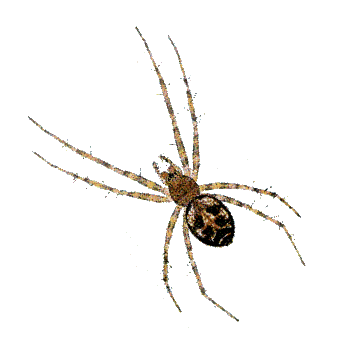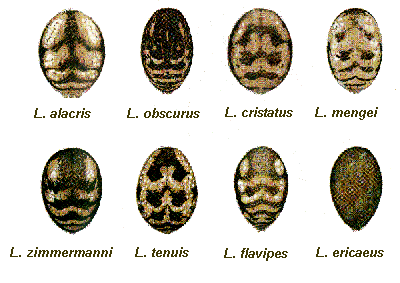

One of the abundantly ubiquitous species in Scotland is Lepthyphantes
zimmermanni.
It may be small and inconspicuous in comparison to the wandering, cursorial
lycosid, but it is found in a wider variety of habitats:
I have taken it in large numbers from woodland, grassland, heathland,
peatbogs, mountains...
L. zimmermanni is a member of the family Linyphiidae, which build sheet webs to capture their prey. This species is very small - its body length is only about two millimetres, and its tiny sheet web is built low down in the vegetation - so no wonder not many people notice it.
As a member of the genus Lepthyphantes, there are several congeneric species of very similar appearance (at least superficially) - in fact, I've cheated with the illustration, which is actually Lepthyphantes minutus, whose name is a misnomer as its body length of 3.5-4mm makes it about the biggest of the Scottish Lepthyphantes.
From the arachnologist's point of view, L. zimmermanni is a nice
species; on first encounter it is quite difficult to identify, but then
its subtle characteristics become obvious and thereafter it becomes a familiar
member of pitfall samples or litter extractions. Apart from slight variations
in size, the Lepthyphantes species can to some extent be recognised
by the patterns on the back of their abdomens,
as shown in this picture:
Another very interesting aspect of L. zimmermanni is its coexistence with other species which share its habitat. For example, there are about a dozen species of the genus Lepthyphantes in this part of the world. To some extent they may be ecologically separated by time (seasonality, active in different months) or by different habitats (e.g. open heaths in contrast to closed woodland). Most interestingly, woodland species have been found to coexist by building their webs at different levels in vegetation of different heights (Alastair Lavery, Ph.D. thesis 1984 , University of Paisley).
Last month's spider, Trochosa terricola , is still numerous during this month and the production of the first batch of young for this year is well under way.
Once again, the illustrations are from that wonderful book by Dr. Mike Roberts : The Spiders of Great Britain and Ireland, published by Harley Books in 1985.
Equally impressive and incredibly useful, featuring more of his illustrations,
is the Collins Field Guide: Spiders of Britain & Northern Europe, Michael
J. Roberts (1995), published by HarperCollinsPublishers.
| Return to..? | |
 Ariadne Home Page
Ariadne Home Page |
|